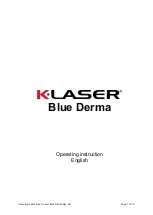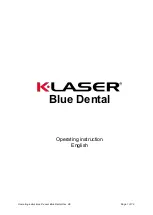
Appendix 1.10 Description of the intelligent adaptive ventilation iSV
App.1-14
Appendix 1.10.5 I:E ratio, medical aspects
Inspiration:expiration (I:E) ratio of a healthy person, as well as of mammals is based on the
physiology of breathing. Expiratory time is usually 2 – 3 times more than inspiratory time. The
natural I:E ratio lies typically in the range of 1:2 – 1:3. This is due to the fact that the breath is
always active and caused by work of the inspiration respiratory muscles (diaphragm, the inter-
costal muscles, straightening ribs).
Expiration at quiet condition is always passive and its implementation requires more time. Full
expiration time takes at least 4 expiratory constants.
At the active physical activity the respiratory rate (and further I:E ratio) increases to eliminate
the carbon dioxide. At the very heavy work the respiratory rate and tidal volume can be in-
creased significantly, expiratory time may become less than 3RC and even 2RC because of
enabling of the expiration muscles. So expiration takes less time than in the quiet state (effect of
pseudo decreasing of the expiratory constant).
At the patient's airway pathology, as well as heavy state due to sepsis, inflammation, fever, ke-
toacidosis at diabetes and so on, significant changes happens in the pattern of breathing.
There is a relationship between the number of expiratory constants in the breathing cycle (T to-
tal) defined by the Otis equation and respiratory mechanics of the patient. The more constants
are "placed" in the breathing cycle, the harder are the lungs, respectively, the less is com-
pliance, respectively, I:E ratio tends to 2:1. And conversely, the less number of the constants
are in the breathing cycle, the higher is the resistance, I:E ratio tends to 1:4 giving priority to ex-
piration.
With the height of the real patient and standard values of compliance and resistance for each
patient height (there is a direct correlation), ideal RB for the patient can be calculated according
to the Otis equation. Comparing this value with the real RB, that takes into account also the
safety limits, operator can get the difference. For example, subtract from RBideal the RBreal,
and get a certain value. If the difference is not large, it is recommended to ventilate with I:E =
1:2. If difference is negative (depending on the degree of deviation), ventilate with 2:1. If posi-
tive, tend to use 1:4.
Appendix 1.10.6 Calculation of the respiratory cycle phases (I:E)
Range of automatic I:E settings is from 2:1 to 1:4. It is also the boundary for correcting of I:E
within the range. The I:E ratios, when the inspiration is longer than expiration are inverse and
requires special enabling.
Algorithm of I:E control supports the following rules:
•
Minimum expiratory time: Te min
≥
2RC;
•
Minimum inspiratory time: Ti min
≥
1 RC, but not less than 0.5 seconds for adults and child-
ren weighing more than 10 kg IBW; in children less than 10 kg IBW - not less than 0.35
seconds.
In the advanced settings the restriction to the inversion "Allow IRV in iSV" (inverse ventilation -
IRV) is provided. IRV is disabled by default. To enable set the range I:E from 2:1 to 1:4, to disa-
ble set 1:1 - 1:4. This is caused by the fact that in some medical facilities ventilation in the inver-
sion mode is not performed.
Summary of Contents for MV200
Page 2: ......
Page 8: ......
Page 25: ...2 3 Front panel 2 9 2 3 Front panel Figure 2 1 Front view of the electronic unit ...
Page 124: ...4 21 Open valve function 4 76 For your notes ...
Page 158: ...6 11 Check and calibration of mainstream CO2 sensor 6 8 For your notes ...
Page 160: ...7 Troubleshooting 7 2 For your notes ...
Page 162: ...8 Transportation 9 Storage 10 Disposal 10 2 For your notes ...
Page 166: ...13 commission date mark 12 2 For your notes ...
Page 168: ...14 Maintenance and repair data 14 2 For your notes ...
Page 196: ...Appendix 2 9 Ideal body weight of the patient IBW App 2 10 For your notes ...
Page 200: ...Appendix 3 Electromagnetic environment App 3 4 For your notes ...
Page 201: ...Appendix 4 Pneumatic scheme of ventilator App 4 1 APPENDIX 4 PNEUMATIC SCHEME OF VENTILATOR ...
Page 202: ...Appendix 4 Pneumatic scheme of ventilator App 4 2 For your notes ...
















































